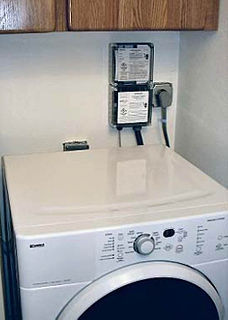Related Research Articles
New Zealand's electricity market (NZEM) is regulated by the Electricity Industry Participation Code administered by the Electricity Authority (EA). The Authority was established in November 2010 to replace the Electricity Commission.
In economic terms, electricity is a consumable energy resource capable of being bought, sold, and traded. An electricity market, also power exchange or PX, is a system enabling purchases, through bids to buy; sales, through offers to sell. Bids and offers use supply and demand principles to set the price. Long-term contracts are similar to power purchase agreements and generally considered private bi-lateral transactions between counterparties.

The electric power industry covers the generation, transmission, distribution and sale of electric power to the general public and industry. The commercial distribution of electric power started in 1882 when electricity was produced for electric lighting. In the 1880s and 1890s, growing economic and safety concerns lead to the regulation of the industry. What was once an expensive novelty limited to the most densely populated areas, reliable and economical electric power has become an essential aspect for normal operation of all elements of developed economies.
Eversource Energy is a publicly traded, Fortune 500 energy company headquartered in Hartford, Connecticut, and Boston, Massachusetts, with several regulated subsidiaries offering retail electricity, natural gas service and water service to approximately 4 million customers in Connecticut, Massachusetts and New Hampshire.

In the electricity sector in the United Kingdom, the National Grid is the high-voltage electric power transmission network serving Great Britain, connecting power stations and major substations and ensuring that electricity generated anywhere on it can be used to satisfy demand elsewhere. The network covers the great majority of Great Britain and several of the surrounding islands. It does not cover Northern Ireland, which is part of a single electricity market with the Republic of Ireland.

Energy liberalisation refers to the liberalisation of energy markets, with specific reference to electricity generation markets, by bringing greater competition into electricity and gas markets in the interest of creating more competitive markets and reductions in price by privatisation. As the supply of electricity is a natural monopoly, this entails complex and costly systems of regulation to enforce a system of competition.
The National Electricity Market (NEM) is an arrangement in Australia's electricity sector for the connection of the electricity transmission grids of the eastern and southern Australia states and territories to create a cross-state wholesale electricity market. The Australian Energy Market Commission develops and maintains the Australian National Electricity Rules (NER), which have the force of law in the states and territories participating in NEM. The Rules are enforced by the Australian Energy Regulator. The day-to-day management of NEM is performed by the Australian Energy Market Operator.

The electricity sector in Canada has played a significant role in the economic and political life of the country since the late 19th century. The sector is organized along provincial and territorial lines. In a majority of provinces, large government-owned integrated public utilities play a leading role in the generation, transmission, and distribution of electricity. Ontario and Alberta have created electricity markets in the last decade in order to increase investment and competition in this sector of the economy.

The Electric Reliability Council of Texas, Inc. (ERCOT) is an American organization that operates Texas's electrical grid, the Texas Interconnection, which supplies power to more than 25 million Texas customers and represents 90 percent of the state's electric load. ERCOT is the first independent system operator (ISO) in the United States and one of nine ISOs in North America. ERCOT works with the Texas Reliability Entity (TRE), one of eight regional entities within the North American Electric Reliability Corporation (NERC) that coordinate to improve reliability of the bulk power grid.

A regional transmission organization (RTO) in the United States is an electric power transmission system operator (TSO) that coordinates, controls, and monitors a multi-state electric grid. The transfer of electricity between states is considered interstate commerce, and electric grids spanning multiple states are therefore regulated by the Federal Energy Regulatory Commission (FERC). The voluntary creation of RTOs was initiated by FERC Order No. 2000, issued on December 20, 1999. The purpose of the RTO is to promote economic efficiency, reliability, and non-discriminatory practices while reducing government oversight.

Demand response is a change in the power consumption of an electric utility customer to better match the demand for power with the supply. Until recently electric energy could not be easily stored, so utilities have traditionally matched demand and supply by throttling the production rate of their power plants, taking generating units on or off line, or importing power from other utilities. There are limits to what can be achieved on the supply side, because some generating units can take a long time to come up to full power, some units may be very expensive to operate, and demand can at times be greater than the capacity of all the available power plants put together. Demand response seeks to adjust the demand for power instead of adjusting the supply.

The Texas Interconnection is an alternating current (AC) power grid – a wide area synchronous grid – that covers most of the state of Texas. The grid is managed by the Electric Reliability Council of Texas (ERCOT).

A smart grid is an electrical grid which includes a variety of operation and energy measures including:

Availability Based Tariff (ABT) is a frequency based pricing mechanism applicable in India for unscheduled electric power transactions. The ABT falls under electricity market mechanisms to charge and regulate power to achieve short term and long term network stability as well as incentives and dis-incentives to grid participants against deviations in committed supplies as the case may be.
Through the 1996 Electric Utilities Act the Alberta's deregulated electricity market began.

ISO New England Inc. (ISO-NE) is an independent, non-profit Regional Transmission Organization (RTO), headquartered in Holyoke, Massachusetts, serving Connecticut, Maine, Massachusetts, New Hampshire, Rhode Island, and Vermont.
The electricity sector in Guyana is dominated by Guyana Power and Light (GPL), the state-owned vertically integrated utility. Although the country has a large potential for hydroelectric and bagasse-fueled power generation, most of its 226 MW of installed capacity correspond to thermoelectric diesel-engine driven generators.

An electrical grid is an interconnected network for electricity delivery from producers to consumers. Electrical grids vary in size and can cover whole countries or continents. It consists of:
The unit commitment problem (UC) in electrical power production is a large family of mathematical optimization problems where the production of a set of electrical generators is coordinated in order to achieve some common target, usually either matching the energy demand at minimum cost or maximizing revenue from electricity production. This is necessary because it is difficult to store electrical energy on a scale comparable with normal consumption; hence, each (substantial) variation in the consumption must be matched by a corresponding variation of the production.
References
- 1 2 3 Committee on Energy and Commerce 2005, p. 226.
- 1 2 Benjamin 2008, p. 24.
- 1 2 3 Wolak & Bushnell 1999, p. 3.
- 1 2 Benjamin 2008, p. 23.
- 1 2 Cramton & Stoft 2005, p. 44.
- ↑ Newbery 2016, p. 420.
- ↑ Benjamin 2008, pp. 23–24.